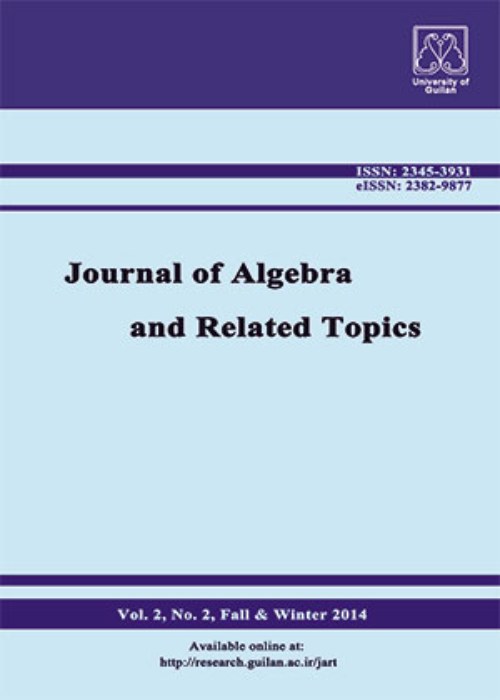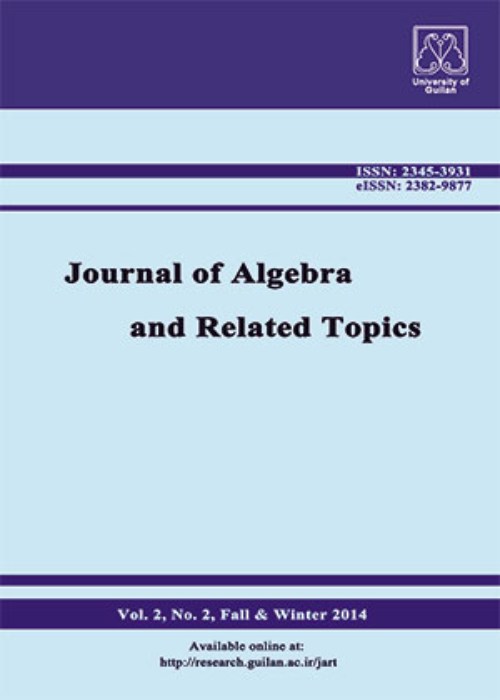فهرست مطالب

Journal of Algebra and Related Topics
Volume:10 Issue: 2, Autumn 2022
- تاریخ انتشار: 1401/09/12
- تعداد عناوین: 11
-
-
Pages 1-12In this paper, we define the co-intersection graph $G(A)$ of an \(S\)-act \(A\) which is a graph whose vertices are non-trivial subacts of \(A\) and two distinct vertices \(B_1\) and \( B_2\) are adjacent if \(B_1 \cup B_2\neq A\). We investigate the relationship between the algebraic properties of an \(S\)-act \(A\) and the properties of the graph $G(A)$.Keywords: S -act, co-intersection graph, subact
-
Pages 13-26For $n = 5, 6$ and $E = \End S_n$, the functions in the centralizer nearring $M_E(S_n) = \{f : S_n \to S_n \ |\ f(1) = (1) \ \hbox{and} \ f \circ s = s \circ f \ \hbox{for all}\ s \in E\}$ are determined. The centers of these two nearrings are also described. Results that can be used to determine the functions in $M_E(S_n)$ and their centers for $n \geq 7$ are also presented.Keywords: Centralizer nearring, symmetric group, center, outer automorphism
-
Pages 27-42Let $R$ be a commutative ring with non-zero identity, and $\delta :\mathcal{I(R)}\rightarrow\mathcal{I(R)}$ be an ideal expansion where $\mathcal{I(R)}$ is the set of all ideals of $R$. In this paper, we introduce the concept of $\delta$-$n$-ideals which is an extension of $n$-ideals in commutative rings. We call a proper ideal $I$ of $R$ a $\delta$-$n$-ideal ifwhenever $a,b\in R$ with$\ ab\in I$ and $a\notin\sqrt{0}$, then $b\in \delta(I)$. For example, an ideal expansion $\delta_{1}$ is defined by $\delta_{1}(I)=\sqrt{I}.$ In this case, a $\delta_{1}$-$n$-ideal $I$ is said to be a quasi $n$-ideal or equivalently, $I$ is quasi $n$-ideal if $\sqrt{I}$ is an $n$-ideal. A number of characterizations and results with manysupporting examples concerning this new class of ideals are given. In particular, we present some results regarding quasi $n$-ideals. Furthermore, we use $\delta$-$n$-ideals to characterize fields and UN-rings.Keywords: $delta$-$n$-ideal, quasi $n$-ideal, $n$-ideal, $delta$-primary ideal
-
Pages 43-50Let $R$ be a commutative Noetherian ring with identity and $M$ be an $R$-module. In this paper, we are going to generalize some results on finiteness of extension functors of local cohomology modules to the category of generalized Laskerian modules. In particular, we study the Laskerianness of $\Ext^1_R(R/\fa, H^t_R(M)))$ and $\Ext^2_R(R/\fa, H^t_\fa(M))$ where $t$ is a non-negative integer.Keywords: Local cohomology modules, Extension functors, Generalized Laskerian module
-
Pages 51-60Let $ \mathcal{A} $ be a standard $ C^{*} $-algebra. In this paper, we will study the continuity of $ \varepsilon $-orthogonality preserving mappings between Hilbert $ \mathcal{A} $-modules. Moreover, we will show that a local mapping between Hilbert $ \mathcal A $-modules is $ \mathcal A $-linear. Furthermore, we will prove that for a pair of nonzero $ \mathcal A $-linear mappings $ T,S:E\longrightarrow F $, between Hilbert $ \mathcal A $-modules, satisfying $ \varepsilon $-orthogonality preserving property, there exists $ \gamma \in \mathbb{C} $,\begin{align*} \Vert \langle T(x), S(y) \rangle-\gamma \langle x, y \rangle\Vert \leq \varepsilon \Vert T\Vert \Vert S\Vert \Vert x\Vert \Vert y \Vert, \quad x, y \in E.\end{align*}Our results generalize the known ones in the context of Hilbert spaces.Keywords: ε-orthogonality preserving mappings, local mappings, Hilbert C*-modules
-
Pages 61-67Let $G=(V, E)$ be a simple graph. A set $C$ of vertices $G$ is an identifying set of $G$ if for every two vertices $x$ and $y$ belong to $V$ the sets $N_{G}[x] \cap C$ and $N_{G}[y] \cap C$ are non-empty and different. Given a graph $G,$ the smallest size of an identifying set of $G$ is called the identifying code number of $G$ and is denoted by $\gamma^{ID}(G).$ Two vertices $x$ and $y$ are twins when $N_{G}[x]=N_{G}[y].$ Graphs with at least two twin vertices are not identifiable graphs. In this paper, we present three bounds for identifying code number.Keywords: code, Strongly, Rayleigh quotient
-
Pages 69-88Let $R$ be a commutative ring with identity and $M$ be an $R$-module. The main purpose of this paper is to introduce and investigate the notion of classical and strongly classical $n$-absorbing second submodules as a dual notion of classical $n$-absorbing submodules. We obtain some basic properties of these classes of modules.Keywords: $n$-absorbing second submodules, classical $n$-absorbing second submodules, strongly classical $n$-absorbing second submodules
-
Pages 89-98In this paper, we introduce a new algorithm for constructing a symmetric pentadiagonal matrix by using three interlacing spectrum, say $(\lambda_i)_{i=1}^n$, $(\mu_i)_{i=1}^n$ and $(\nu_i)_{i=1}^n$ such that\begin{eqnarray*}0<\lambda_1<\mu_1<\lambda_2<\mu_2<...<\lambda_n<\mu_n,\\\mu_1<\nu_1<\mu_2<\nu_2<...<\mu_n<\nu_n,\end{eqnarray*}where $(\lambda_i)_{i=1}^n$ are the eigenvalues of pentadiagonal matrix $A$, $(\mu_i)_{i=1}^n$ are the eigenvalues of $A^*$ (the matrix $A^*$ differs from $A$ only in the $(1,1)$ entry) and $(\nu_i)_{i=1}^n$ are the eigenvalues of $A^{**}$ (the matrix $A^{**}$ differs from $A^*$ only in the $(2,2)$ entry). From theinterlacing spectrum, we find the first and second columns of eigenvectors. Sufficient conditions for the solvability of the problem are given. Then we construct the pentadiagonal matrix $A$ from these eigenvectors and given eigenvalues by using the block Lanczos algorithm. We also give an example to demonstrate the efficiency of the algorithm.Keywords: Inverse eigenvalue problem, Pentadiagonal matrix, Interlacing property, Lanczos algorithm
-
Pages 99-112Let $R$ be a ring and $n$ a non-negative integer. In this paper, we first introduce the concept of $n$-super finitely copresented $R$-modules and via these modules, we give a concept of $n$-weak projective modules and investigate some characterizations of these modules over any arbitrary ring. For example, we obtain that ($\mathcal{WP}^{n}(R), \mathcal{WP}^{n}(R)^{\bot}$) is a perfect hereditary cotorsion theory and for any $N\in \mathcal{WP}^n(R)^{\bot}$, there exists an $n$-weak projective cover with the unique mapping property if and only if every $R$-module is $n$-weak projective.Keywords: $n$-weak projective module, $n$-weak injective module, $n$-super finitely copresented module, $n$-super finitely presented
-
Pages 113-125Since the theory of filters plays an important role in the theory of lattices, in this paper, we will make an intensive study of the notions of semisimple lattices and the socle of lattices based on their filters. The bulk of this paper is devoted to stating and proving analogues to several well-known theorems in the theory of the rings. It is shown that, if $L$ is a semisimple distributive lattice, then $L$ is finite. Also, an application of the results of this paper is given. It is shown that if $R$ is a right distributive ring, then the lattice of right ideals of $R$ is semisimple iff $R$ is a semisimple ring.Keywords: Lattices, Filters, Semisimple-lattices
-
Pages 114-129
TThe invariant $\psi (G)$, the {\it sum of element orders} of a finite group $G$ will be generalized and defined for the finite non-group semigroups in this paper. We give an appropriate definition for the order of elements of a semigroup. As well as in the groups we denote the sum of element orders of a non-group semigroup $S$, which may possess the zero element and$/$ or the identity element, by $\psi (S)$. The non-group monogenic semigroup will be denoted by $C_{n,r}$ where $2\leq r\leq n$. In characterizing the semigroups $C_{n,r}$ we give a suitable upper bound and a lower bound for $\psi (C_{n,r})$, and then investigate the sum of element orders of the semi-direct product and the wreath product of two semigroups of this type. A natural question concerning this invariant may be posed as "For a finite non-group semigroup $S$ and the group $G$ with the same presentation as the semigroup, is $\psi (S)$ equal to $\psi (G)$ approximately?" We answer this question in part by giving classes of non-group semigroups, involving an odd prime $p$ and satisfying $\lim_{p\rightarrow \infty} \frac{\psi (S)}{\psi (G)}=1$. As a result of this study, we attain the sum of element orders of a wide class of cyclic groups, as well.
Keywords: Sum of element orders, Finite group, Non-group semigroups


